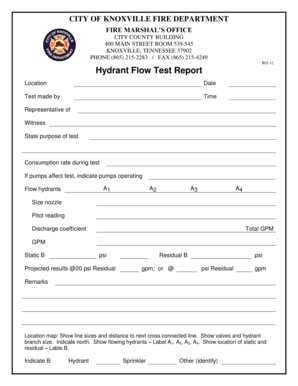Loading

Get Hydrant Flow Test Report
How it works
-
Open form follow the instructions
-
Easily sign the form with your finger
-
Send filled & signed form or save
How to fill out the Hydrant Flow Test Report online
Filling out the Hydrant Flow Test Report is an essential task for ensuring the proper functioning of fire hydrants. This guide provides clear, step-by-step instructions to help users easily complete the form online.
Follow the steps to complete the report efficiently.
- Click the ‘Get Form’ button to obtain the Hydrant Flow Test Report and open it in the editor.
- Begin by entering the location of the hydrant in the designated field. Ensure that the address is clear and specific.
- Fill in the date of the test to document when the assessment took place.
- Enter your name in the 'Test made by' section, ensuring accurate representation.
- Indicate the time when the test was conducted.
- Identify the representative of the organization conducting the test, noting their affiliation.
- If applicable, provide the purpose of the test, which may include reasons such as maintenance or compliance with safety standards.
- Record the consumption rate during the test in the specified field.
- In case pumps affect the test results, indicate which pumps were operating during the assessment.
- Fill in the flow hydrants identified as A1, A2, A3, and A4 with the relevant data.
- Indicate the size of the nozzle used in the test.
- Provide the Pitot reading obtained during the test.
- Enter the discharge coefficient as required.
- Calculate and fill in the total gallons per minute (GPM) for the flow.
- Document the static pressure in psi, labeled as Static B.
- Project the results at 20 psi residual, indicating the residual pressure and corresponding GPM.
- In the remarks section, include any additional information pertinent to the test.
- Create a location map that shows line sizes, distances to the next cross-connected line, valves, and hydrant branch size. Ensure to label the flowing hydrants as A1, A2, A3, and A4, and indicate the locations for static and residual pressures labeled as B.
- Once all fields are filled, make sure to save your changes. You may also choose to download, print, or share the completed form as needed.
Start filling out your Hydrant Flow Test Report online today!
NFPA 291 stipulates hydrant flow tests every five years to ensure that changing conditions in the piping and system demands won't impede hydrants' ability to deliver water. 4.15. 1 Public fire hydrants should be flow tested every 5 years to verify capacity and marking of the hydrant.
Industry-leading security and compliance
US Legal Forms protects your data by complying with industry-specific security standards.
-
In businnes since 199725+ years providing professional legal documents.
-
Accredited businessGuarantees that a business meets BBB accreditation standards in the US and Canada.
-
Secured by BraintreeValidated Level 1 PCI DSS compliant payment gateway that accepts most major credit and debit card brands from across the globe.


